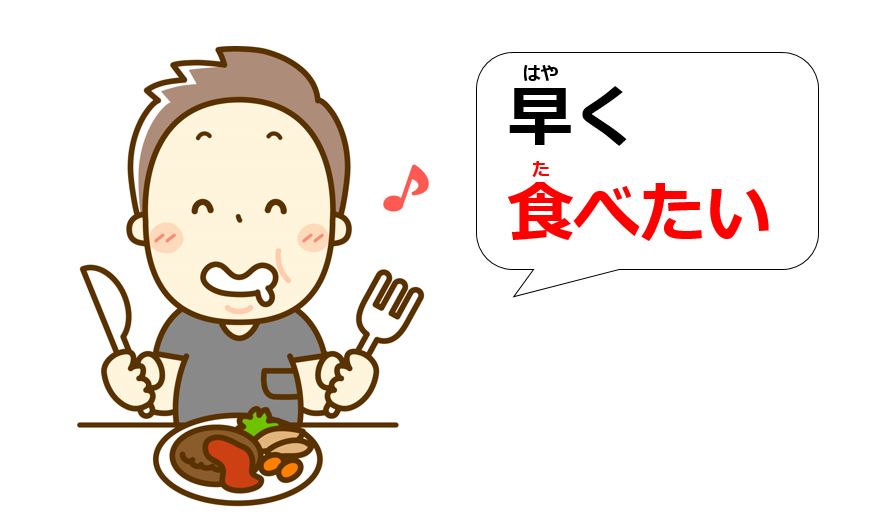Last time, you learned how to express judgments like “漢字は難しそうです (Kanji looks difficult),” and “漢字は難しいようです (It seems that Kanji is difficult).” Then, what if you would like to say that you want to learn Japanese? In this lesson, you will learn how to express your desire.
Explanation for the Usages of …たい, 欲しい, and …て欲しい
| Table of Contents …たい: To Want to Do 欲しい: To Want …に…て欲しい: To Want Someone to Do Something |
In English, you have a useful word: “to want.” By using that, you can express three types of desire, e.g. “I want a textbook,” “I want to study,” and “I want you to study.” In Japanese, you have to use two words to express them.
…たい: To Want to Do
| [私は / が] | 漢字を | 勉強したい(です) |
| [Topic / Subject] | Direct Object | Verb + たい |
| [I] want to study Kanji. | ||
You can consider …たい is the equivalent to “to want to do” in English. The conjugation is simple. You can utilize the polite form and attach たい instead of ます. The たい-form will actually work as an i-adjective. Please don’t follow the conjugation for verbs when you make the polite form and the negative form of the たい-form.
| タクシーに乗りたい(です)。 [I] want to take a taxi. |
| 学校へ行きたく(ない / ありません)。 [I] don’t want to go to school. |
| ジブリの映画が見たかった(です)。 [I] wanted to see a movie made by Ghibli. |
| 野菜は食べたく(なかった / ありませんでした)。 As for vegetables, [I] didn’t want to eat [it]. |
You cannot express another person’s desire because you cannot know exactly how other people feel. You need to utilize some expressions like the following.
| ボブは漢字を勉強したい(です)。 => Unnatural! |
| ボブは漢字を勉強したそう(です)。 Bob looks like that he wants to study kanji. |
| ボブは漢字を勉強したいみたい(です)。 It seems that Bob wants to study kanji. |
Advanced Topic: を (Direct Object) VS. が (Object of Emotion)
| 漢字を勉強したい(です)。 [I] want to study kanji. |
| 漢字が勉強したい(です)。 [I] want to study kanji. |
When the particle を points out direct objects, you can replace it with the particle が. The meanings are the same, but there are some cases where you need to use a particular particle. Be careful; if the particle を has a different function, the replacement doesn’t work. For example, with this sentence: 公園を歩きたいです (I want to walk at the park), the を points out locations to pass.
You Use が When Choosing Something from Options
| 今日はバスケットボールがしたい(です)。 As for today, [I] want to play basketball. |
| 漫画が読みたい(です)。 [I] want to read manga (*when there are other books). |
This is because the particle が has the function to identify something. When you choose something from options, the particle が is more suitable.
You Use が When Doing Routine Actions
| ごはんが食べたい(です)。 [I] want to eat a meal. |
| ビールが飲みたい(です)。 [I] want to drink beer. |
You should just memorize this case without logic. When you want to do routine actions, the particle が should be used.
You Use を When There’re Multiple Conjugations, e.g. ている + たい
| ずっとごはんを食べていたい(です)。 [I] want to be eating a meal forever. |
| いつもビールを飲んでいたい(です)。 [I] always want to drink beer. |
You Use を When There’re Other Elements between the を Part and the Verb
| ごはんをたくさん食べたい(です)。 [I] want to eat a lot of meals. |
| ビールをお父さんと飲みたい(です)。 [I] want to drink beer with my family. |
The particle を is chosen even if the verbs are related routine actions. You can consider that the rules for the particle を are the prior.
[adsense]
欲しい: To Want
| [私は / が] | 辞書が | 欲しい(です) |
| [Topic / Subject] | Object of Emotion | Predicate (I-adjective) |
| [I] want a dictionary. | ||
You can consider 欲しい is the equivalent to “to want” in English. However, here is an important fact. 欲しい is an i-adjective. Therefore, you have to follow the conjugation rule of i-adjectives. As you learned above, when you express another person’s desire, you have to utilize some expressions such as そうだ and ようだ. In this context, you cannot use the particle を.
| 車が欲しい(です)。 [I] want a car. |
| お酒は欲しく(ない / ありません)。 As for alcohol, [I] don’t want [it]. |
| 自転車が欲しかった(です)。 [I] wanted a bicycle. |
| バイクは欲しく(なかった / ありませんでした)。 As for bikes, [I] didn’t want [it]. |
…に…て欲しい: To Want Someone to Do Something
| [私は / が] | 子供に | もっと | 勉強して欲しい(です) |
| [Topic / Subject] | Doer | Adverb | Verb + て欲しい |
| [I] want [my] child to study more. | |||
You can consider that …に…て欲しい is the equivalent to “to want someone to do something.” Doers should be expressed by the particle に, like in causative sentences. The conjugation is simple. First, you make the te-form and attach 欲しい.
| 夫に野菜を食べて欲しい(です)。 [I] want [my] husband to eat vegetables. |
| 昨日は早く来て欲しかった(です)。 As for yesterday, [I] wanted [you] to come early. |
| タバコを吸って欲しく(ない / ありません)。 [I] don’t want [you] to smoke. |
| 子供には携帯を持って欲しく(ない / ありません)。 As for [my] child, [I] don’t want [him] to have a cellphone. |
If you use もらう + たい instead of 欲しい, you can express your desire in a more polite way like “would like someone to do something.” This can be used to make a request.
| 夫に野菜を食べてもらいたい(です)。 |
| 昨日は早く来てもらいたかった(です)。 |
| タバコを吸ってもらいたく(ない / ありません)。 |
| 子供には携帯を持ってもらいたく(ない / ありません)。 |
Summary
- …たい expresses “to want to do.”
- 欲しい expresses “to want.”
- …に…て欲しい expresses “to want someone to do something.”
- 欲しい is i-adjectives and …たい conjugates like i-adjectives.
- You cannot directly express other people’s desire.
This topic shouldn’t be too complicated because you already know how the te-form and i-adjectives conjugate. The advanced topic about を VS. が might be difficult, in which case you can keep it aside. Just pay attention to which function the particle を works as. If it’s direct objects, your Japanese will at least make sense with either the particle を or が. Next, you will learn how to express volition.

How to Express Judgments: そうだ, ようだ, みたいだ, and らしい

How to Express Volition in Japanese: …(よ)う and つもりだ



